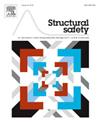另一种贝叶斯主动学习可靠性分析方法
IF 6.3
1区 工程技术
Q1 ENGINEERING, CIVIL
引用次数: 0
摘要
成熟的贝叶斯故障概率推理(BFPI)框架为开发新的贝叶斯主动学习可靠性分析方法奠定了坚实的基础。然而,如何有效利用失效概率的后验统计来设计贝叶斯主动学习的两个关键组成部分:停止准则和学习函数,仍然是一个未决问题。在本研究中,我们提出了另一种创新的贝叶斯主动学习可靠性分析方法,称为 "弱贝叶斯主动学习正交"(WBALQ),它以 BFPI 框架为基础,用于评估极小的故障概率。与依赖后验方差相比,我们提出了一种计算上更可行的方法,即通过检验故障概率的后验第一绝对中心矩来衡量故障概率的认识不确定性。根据这一指标和失败概率的后验均值,我们设计了一种新的停止准则。然后采用最近开发的数值积分器来近似停止准则中固有的两个难以分析的项。此外,还提出了一种新的学习函数,该函数部分来源于认识不确定性度量。我们通过五个数值示例展示了所提方法的性能。结果发现,我们的方法能够以令人满意的精度和效率评估极小的故障概率。本文章由计算机程序翻译,如有差异,请以英文原文为准。
Yet another Bayesian active learning reliability analysis method
The well-established Bayesian failure probability inference (BFPI) framework offers a solid foundation for developing new Bayesian active learning reliability analysis methods. However, there remains an open question regarding how to effectively leverage the posterior statistics of the failure probability to design the two key components for Bayesian active learning: the stopping criterion and learning function. In this study, we present another innovative Bayesian active learning reliability analysis method, called ‘Weakly Bayesian Active Learning Quadrature’ (WBALQ), which builds upon the BFPI framework to evaluate extremely small failure probabilities. Instead of relying on the posterior variance, we propose a more computationally feasible measure of the epistemic uncertainty in the failure probability by examining its posterior first absolute central moment. Based on this measure and the posterior mean of the failure probability, a new stopping criterion is devised. A recently developed numerical integrator is then employed to approximate the two analytically intractable terms inherent in the stopping criterion. Furthermore, a new learning function is proposed, which is partly derived from the epistemic uncertainty measure. The performance of the proposed method is demonstrated by five numerical examples. It is found that our method is able to assess extremely small failure probabilities with satisfactory accuracy and efficiency.
求助全文
通过发布文献求助,成功后即可免费获取论文全文。
去求助
来源期刊

Structural Safety
工程技术-工程:土木
CiteScore
11.30
自引率
8.60%
发文量
67
审稿时长
53 days
期刊介绍:
Structural Safety is an international journal devoted to integrated risk assessment for a wide range of constructed facilities such as buildings, bridges, earth structures, offshore facilities, dams, lifelines and nuclear structural systems. Its purpose is to foster communication about risk and reliability among technical disciplines involved in design and construction, and to enhance the use of risk management in the constructed environment
 求助内容:
求助内容: 应助结果提醒方式:
应助结果提醒方式:


